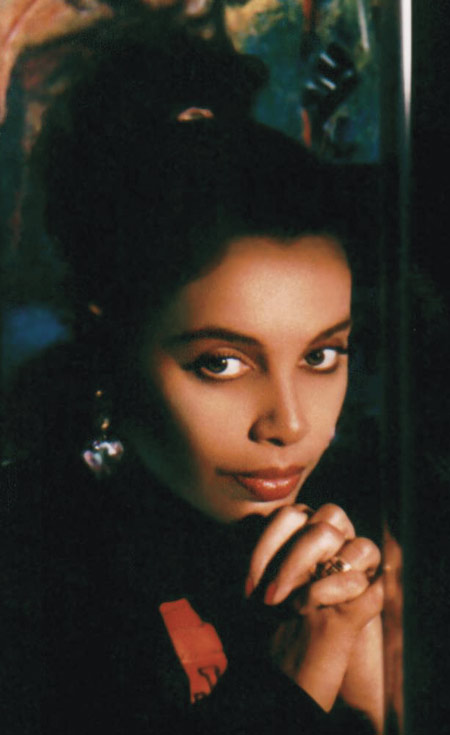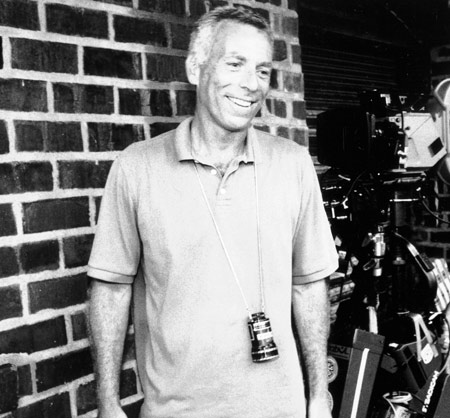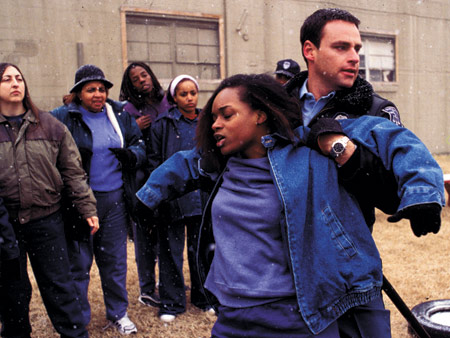Monica Calhoun (left) N'Bushe Wright, Lisa Raye and Larke Voorhies in Civil Brand
Few locations can impact the look and feel of an indie film like shooting inside a prison. Whether it's a dilapidated, state penitentiary in Tennessee, ghostly and out-of-service like the one Neema Barnette used for Civil Brand, or a bustling city jail in Washington, D.C., as Marc Levin showcased in Slam, taking an indie crew "over the walls" provides a stark, unassailable reality to a director's vision. The process, and the product, often changes lives — filmmakers, actors, and audiences alike leave the experience transformed and affected.
Civil Brand is a fine example. The story of a group of incarcerated black women who rise up against the inmate labor system was barred from its original North Carolina filming site for themes critical of prison work programs. Barnette's back-up location — the Tennessee prison featured in The Green Mile — was a badly deteriorated historical landmark that lacked heat and leaked profusely during rain. Yet after Barnette met with real female inmates in Nashville (and researched the Corrections Corporation of America, which oversees all inmate labor programs), she knew Civil Brand had to be shot inside a real prison, or not at all. Fearful she would lose her Nashville location, as she had in North Carolina, Barnette submitted alternate versions of Civil Brand's script to Tennessee prison officials. But that was only the start of a shoot that featured conditions so deleterious, Barnette felt like she was living her own film.

Director Neema Barnette
Nashville prison officials gave Barnette free reign to choose her locations inside the prison. However, due to a slashed budget and shooting schedule that was cut from 30 to 15 days, Barnette couldn't afford to move the company around the vast structure. "I designed scenes and shots based on their proximity and how much light I could stream in through windows, to minimize setup time," she said. "The prison's interior was a mess, and we only had time and money to paint a single cellblock. Individual cells were too tight to fly or move any cameras around; I needed removable walls, so I built a cell set, but the abbreviated schedule precluded us from using it."
Rather than design complicated shots for a wheelchair camera (Barnette had no dolly), the director pulled back on the cellblock in static frames and let the women gather in the corridor. Barnette cites the weather as a contributing factor. "We had no money to heat the prison," she added, "and the rain and cold ended up putting my AD, Don Wilkinson, in the hospital with pneumonia right before shooting began."
Whether real or make-believe, prison life is hard, and Barnette's challenges only seemed to increase. She drew on her many years as a Guild TV director to fill in the gaps. Calling her Nashville-based union crew "one of the most supportive and dedicated I've ever seen," Barnette built a harrowing isolation set inside the prison, with windows for a cold-light effect, and an open top to shoot 360s and high angles. She used a real sweatshop for a key "work-stoppage" scene by Civil Brand inmates, restaging on the spot when only 10 extras, including members of her crew, showed up to challenge the prison guards. To fill out "the yard" for a key fight scene, the centerpiece of action for most prison films, Barnette posted flyers at a local Nashville college calling for young women with denim and blue jeans. Thirty college students came on one day's notice, and Barnette carefully framed off a small corner of the yard, avoiding any true reverse angles, to reveal its huge size and emptiness.

Director Marc Levin
Marc Levin had a much different experience for his Washington, D.C.-based Slam, the story of a gifted young poet/rapper who is caught between rival gangs in prison. Levin had been shooting a documentary for HBO's America Undercover series in the D.C.'s central jail when he approached warden Pat Jackson about shooting a feature that would highlight creativity in the rehabilitation process. The year was 1996, and Congress, outraged that convicted felon Marion Barry had been reelected as Washington's mayor, was trying to dismantle D.C.'s criminal justice system.
"I went into the superintendent's office (for D.C. correction facilities) and she had the congressional hearings on TV," Levin said. "As I was outlining the story and talking about permits, insurance, liability waivers, etc., she turned and said: 'if you can shoot it in two weeks, then I don't want to hear about it.' We were already shooting an HBO documentary in the jail, so we took a skeleton crew of 10 people, and shot Slam in Super 16mm with no playback. We used available light, with the occasional reflector card, and never bothered with permits or waivers. Our plan all along had been to use real inmates in some of the roles, so we set up acting workshops to see which prisoners had talent and wanted to participate."
Four days into shooting, D.C. jail guard Allan Lucas, who played Slam's chief corrections officer, had words with a real inmate following Lucas's on-camera monologue. Within moments, the jail erupted into a "Code Blue" incident; Levin and his entire crew were placed in a holding cell while the riot squad came down. "I had to report to the warden's office the next morning," Levin said. "I thought we would be thrown out of the jail for starting the Code Blue. But she surprised me by asking why we hadn't filmed it. Then she said to have my crew ready and my camera loaded at 4:30, when she would call another Code Blue for the film!"
The scene is frightening for its real-life intensity. Like a studio chief taking charge, warden Pat Jackson signaled the Code Blue after Levin was rolling. "The alarms went off, the guards roared through the place, and the inmates went crazy," Levin marvels. "When I called cut, everyone stopped and made sure no serious injuries had occurred. It was a cathartic experience for the guards and the inmates."
Slam's climax in the prison yard pushed Levin's methods to the extreme. Given only one hour by the warden, Levin and his DP, Mark Benjamin, shot hand-held single camera, in real-time. With the small crew and continuous action, many inmates did not know Levin was making a movie. "Some of the rival gangs were about to jump Saul Williams (Slam's lead actor)," Levin recalled. The director's run-and-gun style was summed up in the crew's motto: "God is our gaffer." Levin clapped his own head and tail slates (when he could) and shot full 11-minute Super 16mm loads, swapping out new magazines to keep pace with the actors.

Wright and Robert Lynn in Civil Brand
"The standard feature mentality — blocking, staging, and storyboarding — choreographs a moment," Levin said. "Shooting documentary style captures a moment, and Slam told itself in that way."
Levin said the biggest challenge shooting behind bars is ultimately one of trust. "Everyone involved with the prison system can tell if you're for real," Levin said. "It then becomes: how do you get this institution — inmates, guards, and administrators — to be on your side? They can screw up your film in a thousand ways without ever threatening your physical safety."
For Neema Barnette, the experience of going over the walls was well worth all the hassles. "There's a haunting, resonant feeling inside a prison that you cannot duplicate," Barnette said. "My actors came to work every day in a cellblock right next to the gas chamber. Even if it's no longer in service, like our Nashville prison, the place invades your story. Many of the actors in
Civil Brand had never been inside a prison, so being there gave them perspective and a foundation for their characters' lives. It was a very emotional experience."